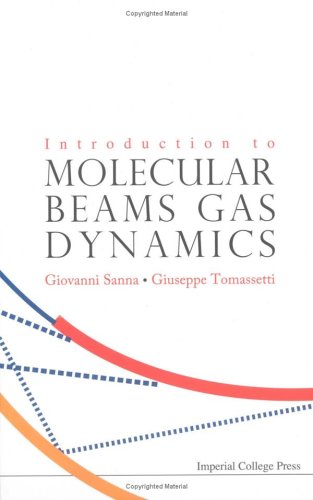Giovanni Sanna; Giuseppe Tomassetti1860945562, 9781860945564
Table of contents :
CONTENTS……Page 12
Preface……Page 8
1.2 Perfect and Real Gases……Page 20
1.3 Intermolecular Forces……Page 21
1.4 Gas Internal Energy……Page 25
1.5 Distribution of the Molecules on the Available Energy States……Page 27
1.6 The Internal Energy of Polyatomic Molecules……Page 29
1.7 The Specific Heats and their Ratio……Page 31
1.8 The Molecular Velocity Distribution. Averaged Values……Page 34
1.9 The Mean Free Path and the Transport Coefficients……Page 35
1.10 Classical Dynamics of Binary Collisions……Page 41
1.11 The Collision Integrals……Page 51
1.12 Effusive Sources……Page 55
1.13 Different Regimes of a Gas in Thermal Equilibrium……Page 58
1.14.1 Gas in equilibrium……Page 59
1.14.2 Gas in non-equilibrium……Page 62
References and Notes……Page 65
2.2 The Boltzmann Transport Equation……Page 67
2.3 The Wang Chang-Uhlembeck and the Master Equations……Page 69
2.4 Energy Transfer During Collisions……Page 72
2.5 The Vibrational Energy Relaxation……Page 76
2.6 The Rotational Energy Relaxation……Page 83
References and Notes……Page 87
3.1 Introduction……Page 89
3.2 Notes on the Fluid Motion……Page 90
3.3 Kinematics of a Fluid Element……Page 93
3.4 The Forces Acting on Fluids……Page 96
3.5 More on the Forces on a Fluid Element……Page 99
3.6 The Stress-Strain Relationship for a Viscous Fluid……Page 102
3.7 The Navier-Stokes Equations……Page 106
3.8 The Reynolds Number……Page 108
3.9 The Fundamental Equations of Fluid Dynamics……Page 109
3.10 The Bernoulli Theorem for Compressible Fluids……Page 114
3.11 The Propagation of Small Disturbances through a Compressible Fluid……Page 116
3.12 The Gas Dynamic Equation……Page 119
3.13 The Boundary Layer……Page 122
3.14 The Crocco Theorem……Page 125
References and Notes……Page 128
4.2 Isoentropic and Stationary Flow of a Perfect Gas……Page 129
4.3 Temperature and Stagnation Pressure……Page 135
4.4 The Flux Density……Page 137
4.5 Propagation of Small Disturbances in a Gas in Equilibrium. Characteristic Lines……Page 139
4.6 The Propagation of Finite Amplitude Disturbances. Characteristic Lines……Page 141
4.7 Compression and Rarefaction Waves……Page 144
4.8 Generation of Compression and Rarefaction Waves in a Gas Inside a Tube……Page 148
4.9.1 Compression waves……Page 152
4.9.2 Rarefaction waves……Page 154
References and Notes……Page 156
5.1 Introduction……Page 157
5.2 The Differential Equations of the Characteristics……Page 158
5.3 Applications……Page 162
5.4 Alternative Form of the Compatibility Equations……Page 171
5.5 Properties of the Characteristic Lines. Weak Discontinuities……Page 174
5.6 The Equations of the Planar Isoentropic Flow in the Hodograph Plane……Page 175
5.7 Weakly Perturbed Two-Dimensional Flow. Mach Lines……Page 181
5.8 The Flow Near a Curved Wall……Page 186
5.8.1 Flow near a concave wall……Page 187
5.8.2 Flow near a convex wall……Page 190
5.9.1 Reflection from a frictionless rigid wall……Page 195
5.9.2 Reflection from a constant pressure free boundary……Page 198
5.10 Intersection of Rarefaction and Compression Waves……Page 201
References and Notes……Page 204
6.1 Introduction……Page 205
6.2 Discontinuities in the Flow Fields……Page 206
6.3 Normal Shock. Shock Adiabatic……Page 208
6.4 Application to a Perfect Gas……Page 210
6.5 The Flow Variables Downstream of the Shock as Functions of the Upstream Mach Number……Page 212
6.6 The Oblique Shock……Page 217
6.7 The Relationship Between the Deflection and Shock Angles……Page 221
6.8 The Detached Shock……Page 225
6.9.1 Hodograph shock polar……Page 228
6.9.2 Pressure-deflection shock polar……Page 231
6.10.1 Regular shock reflection from a planar rigid wall……Page 233
6.10.2 Mach reflection (M.R.) of an oblique shock……Page 235
6.10.3 Reflection of the shock from the free boundary between a moving and stagnating gas……Page 238
6.11 Shock Interactions……Page 239
References and Notes……Page 241
7.2 Stationary and Isoentropic Flow in Variable Section Ducts……Page 243
7.3 Expressions of the Nozzle Flow Rate……Page 248
7.4 Effects of the Discharge Pressure Reduction……Page 252
7.5 Flow Regimes of a de Laval Nozzle. The Emitted Jet……Page 256
7.6 Flow Regimes of a Converging Nozzle. The Emitted Jet……Page 265
References and Notes……Page 269
8.2 The Axisymmetric Under-expanded Jet Emitted from Converging Nozzle……Page 270
8.3 The Jet Dimensions……Page 274
8.4 Variations of the Variables in the Continuous Regime……Page 277
8.5 Non-Equilibrium Cooling of a Monatomic Gas……Page 280
8.6 Non-Equilibrium Cooling of a Polyatomic Gas……Page 284
8.7 The Sudden Freeze Approximation……Page 288
8.8 Influence of the Relaxation of an Internal Degree of Freedom on the Flow Variables……Page 292
References and Notes……Page 297
9.2 Fundamental Hypotheses and the Method of Moments……Page 298
9.3 Calculation of the Collisional Term……Page 302
9.4 The Moment Equations in Reduced Forms……Page 306
9.5 Some Considerations about the Obtained Equations……Page 309
9.6 Calculation of the Parallel Speed Ratio……Page 311
9.7 Comparison with the Experimental Data……Page 314
References and Notes……Page 317
10.2 Characterisation of a Particle Source……Page 318
10.3 The Virtual Source and the Non-Maxwellian Distribution of v1……Page 322
10.4 Extraction of a Molecular Beam by a Skimmer……Page 327
References……Page 336
11.1 Introduction……Page 337
11.2 The Gas Expansion in the p-T Phase Diagram……Page 338
11.3 The Dimers Formation Mechanism……Page 339
11.4 The Dimers Formation Rate……Page 341
References……Page 346
12.2.1 Pure monatomic gas……Page 347
12.2.2 Pure biatomic gas……Page 348
12.2.5 Mixture of a monatomic gas (carrier) with a biatomic gas (sample)……Page 349
12.3.1 Mixture in equilibrium……Page 350
12.3.2 Free jet of a binary mixture……Page 351
12.4 Expressions of the Molecular Beam Intensity……Page 356
References……Page 361
Appendix A.1 Different Forms of Eq. (1.2.2)……Page 362
Appendix A.2 Intermolecular Potential Energy……Page 363
Appendix A.3 Molecular Energy Levels……Page 364
Appendix B.1 Deduction of Eqs. (2.5.8;9;10)……Page 367
Appendix C.1 Deduction of Eqs. (3.9.10;13)……Page 368
Appendix C.2 Alternative Deduction of the Bernoulli Equation……Page 371
Appendix D.1 Use of the Prandtl-Meyer Function in the Method of Characteristics……Page 372
Appendix D.2 Planar Flow Classification……Page 373
Appendix D.3 Characteristic Lines and Weak Discontinuities……Page 375
Appendix E.1 Spherical Symmetry Source……Page 379
Appendix E.2 A New Determination of the Flow Field……Page 381
Appendix E.3 Deduction of Eqs. (8.5.1;2)……Page 385
Appendix F.1 Deduction of Eqs. (9.2.9;10;11;12)……Page 387
Appendix F.2 Deduction of Eqs. (9.3.5;6)……Page 390
Appendix F.3 Deduction of Eq. (9.3.14)……Page 393
Appendix G.1 Calculation of the Integral /1 and /2 in Eqs. (12.4.7;14)……Page 394
Index……Page 398

Reviews
There are no reviews yet.